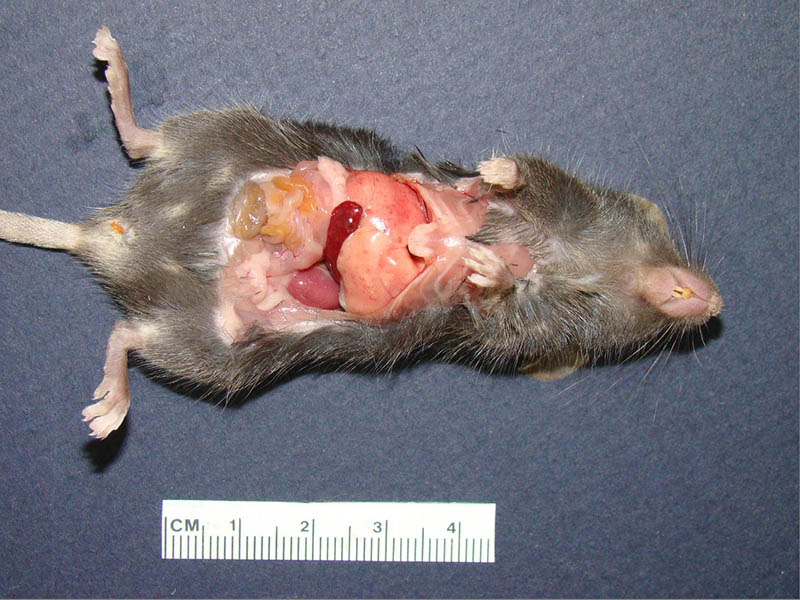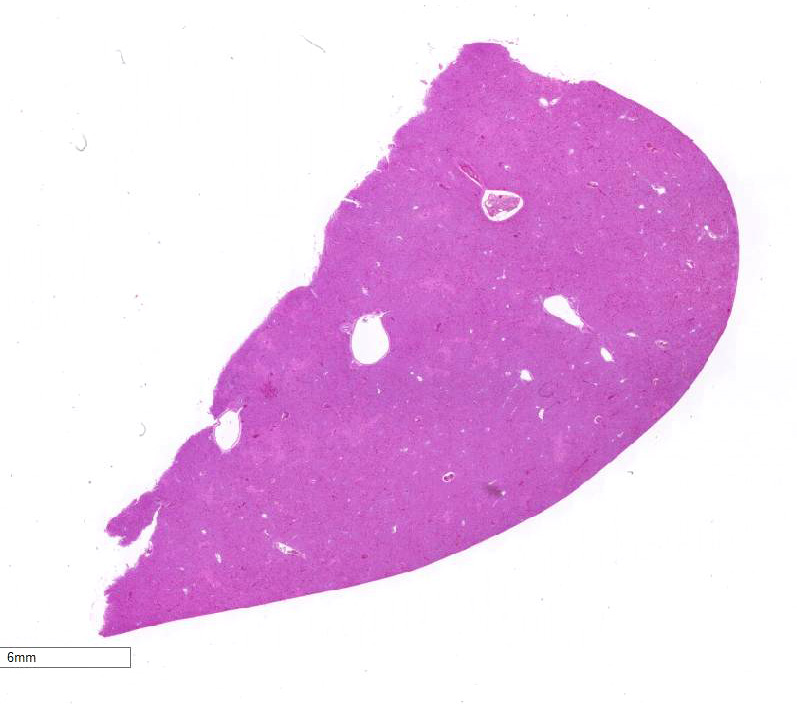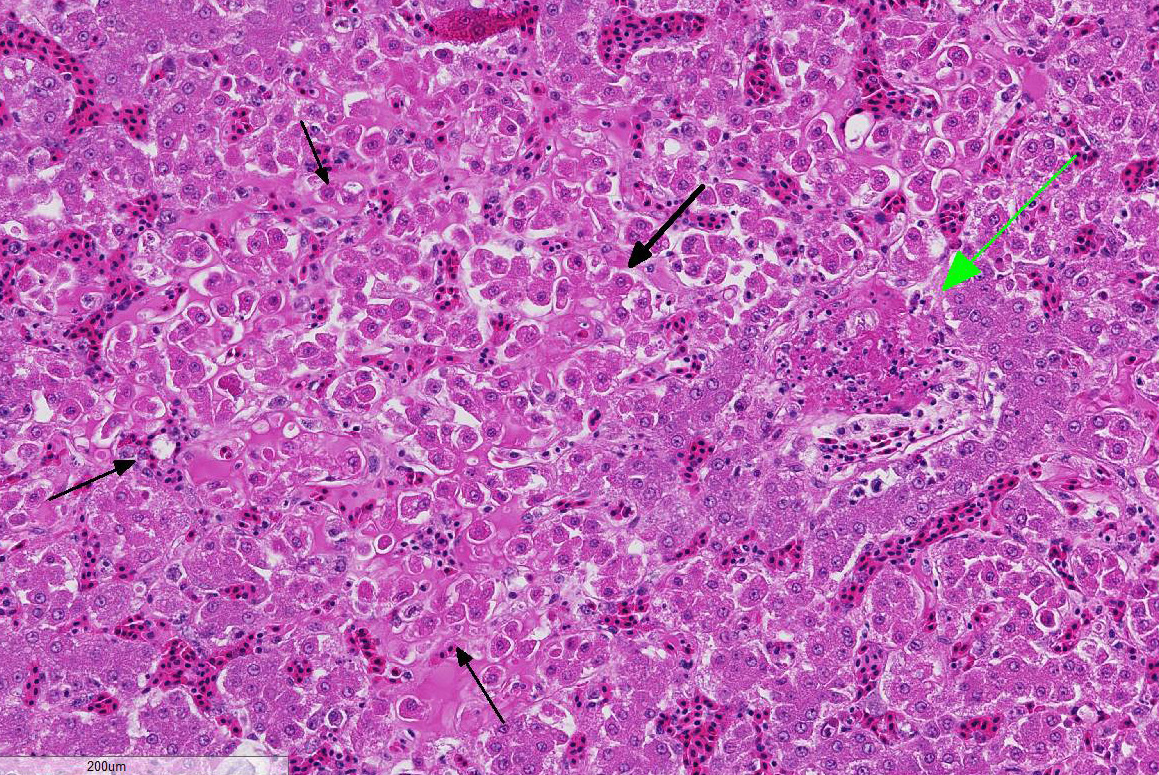Signalment:
11-month-old B6.129S-Cybbtm1Din/J mouse (Mus musculus)
A breeding colony of B6.129S-Cybbtm1Din/J mice were housed in an AAALAC International accredited facility. The mice were housed in static micro isolator cases with ad libitum autoclaved food (NIH-31) and beta chip bedding. Mice were provided acidified water due to imm-unocompromised state. The mice were housed in the same room as B6 imm-unocompetent mice. Sudden deaths were noted in the colony over a weekend. A total of 87 mice, aged from one to eleven months were affected. Of these, 45 mice were found dead and 19 sick mice were euthanized and necropsied. Twenty males and 38 females were affected.
Gross Description:
The livers were pale and slightly enlarged. In most of the mice, there were multifocal tan foci in the liver, spleen and lung.
Histopathologic Description:
Liver: Multifocally and randomly, there are areas of hepatocyte necrosis containing cellular and karyorrhectic debris and moderate nu-mbers of degenerate neutrophils. Mu-ltifocally, many blood vessels contain thrombi. There are large areas of coagulative necrosis surrounding these thrombosed blood vessels. Multifocally, the hepatocyte cytoplasm is vacuolated (glycogen) and, contain clear round vacuoles (lipid). Multifocal portal areas are infiltrated by small numbers of lymphocytes. No bacteria were present in the Grams stained liver section.
Morphologic Diagnosis:
Liver: Hepatitis, necrosuppurative, multifocal, random, moderate with vascular thrombosis.
Lab Results:
From multiple tissues, a pure culture of Burkholderia spp. was isolated. The isolate was further characterized as Burkholderia cepacia with PCR. In the blood smears, monocytes contained bacterial rods.
Condition:
Contributor Comment:
B6.129S-Cybbtm1Din/J mouse is a targeted mutant lacking superoxide production in phagocytes.9 129S6 mice is the embryonic stem cell donor in which cytochrome b-245, beta polypeptide(Cybb) targeted mu-tation(tm) was created by Dr. Mary C Dinauer(Din) accessed on August 5, 2011). Superoxide production is critical in host defense. Therefore, mice lacking superoxide pro-duction are immunocompromised. This mouse is an animal model for X-linked chronic granulomatous disease in humans.9 These mice are susceptible to various bacterial and fungal infections.9 Based on the gross lesions in the affected mice differential diagnoses included septicemia, mouse hepatitis viral infection, pox viral infection and Tyzzers disease. His-tologically, the absence of syncytial cells and intracytoplasmic in-clusions helped to eliminate the possibility of mouse he-patitis virus and poxvirus in-fection, respectively. Absence of bacilli in and around the necrotic hepatocytes, el-iminated the possibility of Tyzzers disease. The hi-stologic changes in the current case were consistent with a septicemic process. This was supported by the isolation of bacteria and evidence of bac-teremia. Burkholderia cepacia complex includes nine members. The bacteria are ubiquitous in nature and can cause pneumonia and se-pticemia in cystic fibrosis and chronic granulomatous disease patients. In the current outbreak the source of infection could not be determined. Because B6.129S-Cybbtm1Din/J mouse is a model for X-linked CGD,9 only male mice should have been affected. However, both males and females were affected in the current case. One possible explanation could be that certain numbers of cells in females can have the mutant X-chromosome resulting in a full expression of an X-linked condition.5 Also, spontaneous infections with various pathogens in both males and females have been previously reported in this mouse model.2
JPC Diagnosis:
Liver:-Hepatitis, ne-crotizing, multifocal, random, marked with fibrin thrombi.
Conference Comment:
Burkholderia cepacia complex includes a group of motile, aerobic, gram-negative bacilli that are ubiquitous in the environment and can be isolated from soil, vegetables and water.1 -They act as endophytic bacteria on certain types of vegetation and have been used as a potential catalysts, involved in the formation of enzymes, used in the creation of alternative energy sources from perennial grasses.6 Due in part to the presence of antibiotic resistance mechanisms, they are also important bacterial pathogens in the hospital setting,1 and are important op-portunistic pathogens in cases of septicemia and lung infection in cystic fibrosis patients.4- The organism has also been isolated from the deep pyoderma in dogs on immunosuppressive therapy (cyclosporine).In those cases the clinical course was acute and infection was widespread.Because B. cepacia is not a commensal on canine skin, it is presumably acquired either from the environment or within hospitals, although reports of environmental B. cepacia in veterinary practices are rare.B. cepacia has also been reported to cause subclinical mastitis in dairy sheep.1
As discussed above, the transgenic mice in this case are deficient in superoxide pro-duction in phagocytes.Once phagocytosis of an opsonized particle takes place within a neutrophil, usually via binding of com-plement or Fc receptors, internal signaling cascades are initiated involving various GTPases and protein and lipid kinases, eventually resulting in release of calcium from the endoplasmic reticulum and production of the oxidative burst within ph-agolysosomes. The oxidative burst is in-itiated by formation of the nicotinamide adenine dinucleotide phosphate (NADPH) oxidase, which stimulates generation of superoxide free radicals, critical in microbial killing.8 In this case, a mutation in NAPDH oxidase is involved in superoxide deficiency and absence of a functional respiratory burst.9 -Reactions involving superoxide anion result in the formation of hydrogen peroxide, hydroxyl radical and hypochlorous acid as well as peroxynitrate, all of which are important microbicidal agents.8
The conference histologic description was very similar to the contributors description above.Not all sections have prominent fibrin thrombi but in sections with thrombi areas of necrosis appear spatially associated with thrombosed vessels.The differential diagnosis for this lesion includes Helicobacter hepaticus, Salmonella spp., Proteus mirabilus and Clostridium piliforme as well as some viral conditions such as mouse hepatitis virus, as mentioned above.Both Gram stains and silver stains failed to identify infectious organisms.Conference participants discussed B. cepacia and its various virulence factors including lipopolysaccharide (LPS), exotoxins, lipases, siderophores and proteases as well as the inherent antibiotic resistance of its cell envelope.7
References:
1. Banovic F, Koch S, Robson D, Jacob M, Olivry T.Deep pyoderma caused by Burkholderia cepacia complex associated with ciclosporin administration in dogs: a case series. Vet Dermatol. 2015; 26:287-e64.
2.Bingel SA. Pathology of a mouse model of x-linked chronic granulomatous disease. Contemp Top Lab Anim Sci. 2002;41: 33-38.
3.Coenye T, Vandamme P, Govan JR, LiPuma JJ. Taxonomy and identification of the Burkholderia cepacia complex. J Clin Microbiol. 2001;39: 3427-3436.
4.Folescu TW, da Costa CH, Folescu Cohen RW, da Conceicao Neto OC, et al. Burkholderia cepacia complex: Clinical course in cystic fibrosis patients. BMC Pulm Med. 2015;15:158.
5. Kumar V, Abbas A, Fausto N, Aster J. Pathologic Basis of Disease. 8th ed., Saunders; 2010:135-182.
6.Leo VV, Passari AK, Joshi JB, Mishra VK, et al.A novel triculture system (CC3) for simultaneous enzyme production and hydrolysis of common grasses through submerged fermentation.Front Microbiol. 2016;7:447.
7.Mahenthiralingam E, Urban TA, Goldberg JB. The multifarious, multireplicon Burkholderia cepacia complex. Nat Rev Microbiol. 2005;3:144-156.
8.Myers RK, McGavin D, Zachary JF.Cellular adaptions, injury, and death: Morphologic, biochemical and genetic bases.In: McGavin MD, Zachary JF, eds. Pathologic Basis of Veterinary Disease. 5th ed. St. Louis, MO: Mosby Elsevier; 2012:100-101.
9. Pollock JD, Williams DA, Gifford MA, Li LL, D et al. Mouse model of X-linked chronic granulomatous disease, an inherited defect in phagocyte superoxide production. Nat Genet. 1995;9: 202-209.


